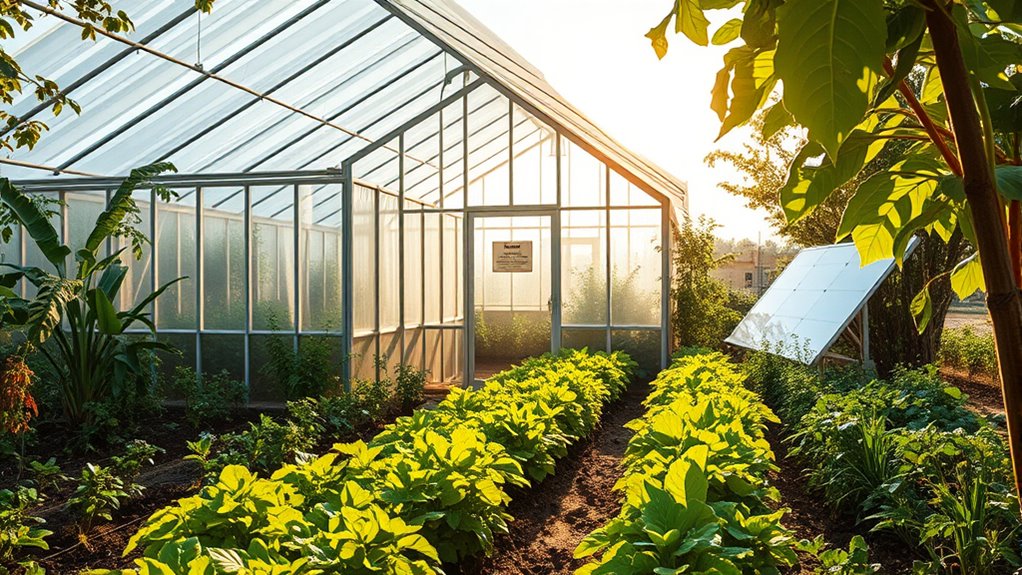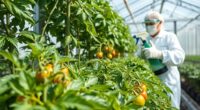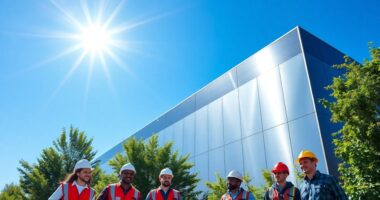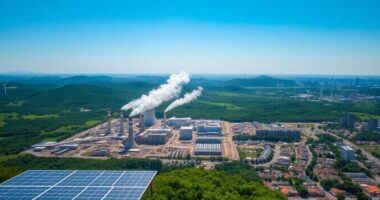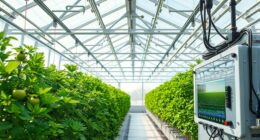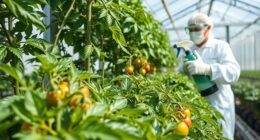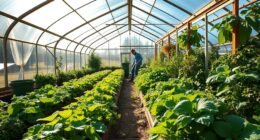Greenhouses play a vital role in disaster preparedness by providing a reliable source of fresh food during emergencies. They create controlled environments for year-round crop growth, reducing dependence on weather and external supply chains. Using renewable energy and rainwater harvesting, greenhouses can operate independently even during power outages or infrastructure failures. This setup boosts urban resilience and community self-sufficiency. If you want to discover how greenhouses can strengthen your food security in crises, keep exploring these strategies.
Key Takeaways
- Greenhouses provide a reliable, controlled environment for year-round crop production during emergencies.
- Incorporating renewable energy ensures continuous operation despite power outages.
- Water harvesting and autonomous systems maintain irrigation without external utilities.
- Urban greenhouses maximize limited space, reducing dependence on external food supply chains.
- Greenhouses serve as educational hubs, promoting community resilience and sustainable disaster preparedness.
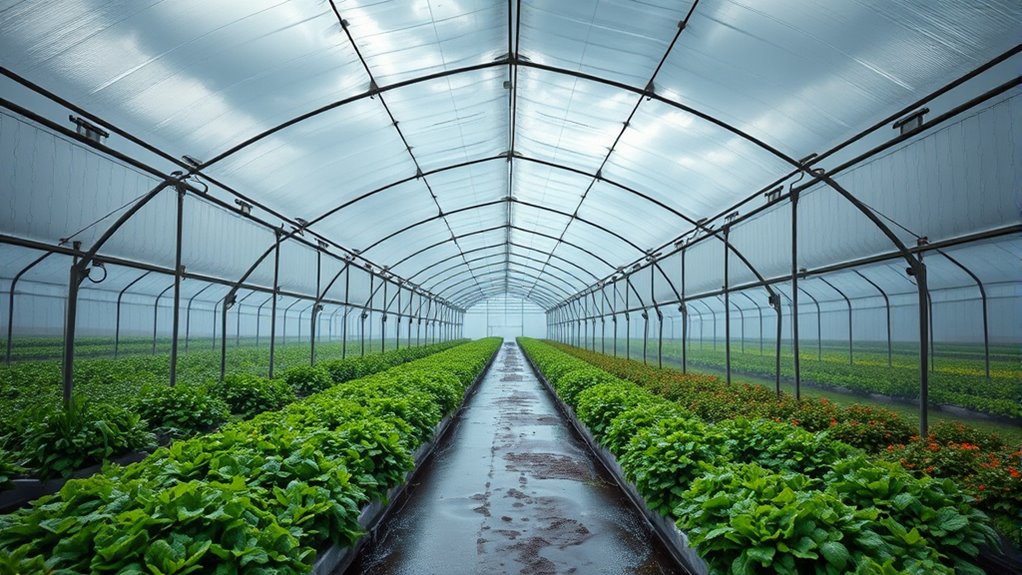
Have you ever considered how greenhouses can play a critical role in disaster preparedness? When emergencies strike—whether natural disasters, economic crises, or disruptions to supply chains—having a reliable source of fresh food becomes indispensable. Greenhouses offer a strategic advantage in these situations, especially if you’re involved in urban farming. By integrating greenhouses into your disaster planning, you create a controlled environment where you can grow a variety of crops year-round, regardless of outside conditions. This independence from external weather patterns guarantees that you and your community can maintain a steady food supply during times of crisis.
Using greenhouses for urban farming allows you to maximize limited space efficiently. Even in densely populated areas, you can set up compact, productive greenhouses that provide a sustainable source of vegetables, herbs, and even small fruits. This local food production reduces reliance on distant supply chains, which often break down during emergencies. When you prioritize urban farming in your disaster preparedness plan, you’re not just securing food—you’re also empowering yourself and your community to be more self-sufficient.
To strengthen the resilience of your greenhouse-based food system, incorporating renewable energy sources becomes essential. Solar panels, wind turbines, or other renewable options can power your greenhouse operations sustainably, especially when traditional energy grids are compromised. Renewable energy reduces dependence on fossil fuels and guarantees your greenhouse can operate independently during power outages. This approach not only sustains your crop production but also minimizes your environmental footprint, aligning with long-term sustainability goals.
Imagine setting up a greenhouse that’s powered primarily by solar energy, with rainwater harvesting systems to irrigate your plants. During a disaster, when municipal utilities might be down, your energy and water supplies remain stable. This autonomy prevents many of the logistical hurdles that come with disrupted infrastructure. Plus, renewable energy systems are scalable; whether you’re managing a small urban farm or a larger community greenhouse, you can adapt these solutions to fit your needs and budget.
Furthermore, greenhouses integrated with renewable energy can serve as educational hubs, raising awareness about sustainable practices and disaster resilience. By demonstrating how renewable energy can power urban farming, you inspire others to adopt similar strategies. This collective effort enhances community resilience, making neighborhoods more prepared and adaptable in times of crisis. In essence, greenhouses combined with renewable energy not only secure food but also foster a mindset of sustainability and preparedness that benefits everyone during emergencies. Investing in reliable projectors can also enhance community training sessions on sustainable practices and emergency preparedness.
Frequently Asked Questions
How Cost-Effective Are Greenhouses for Emergency Food Production?
Greenhouses can be quite cost-effective for emergency food production when you do a thorough cost analysis and consider their economic feasibility. While initial setup costs might seem high, they often pay off by providing a controlled environment that extends growing seasons and boosts yields. Over time, greenhouses save money on food supplies and reduce reliance on external sources, making them a smart investment for securing food during emergencies.
What Are the Best Greenhouse Designs for Disaster Resilience?
Think of resilient greenhouses as fortresses for your food supply. The best designs feature robust frames and insulation, with climate control systems that adapt to extreme weather. Incorporate hydroponic systems for efficient, soil-free cultivation, reducing vulnerability. These designs minimize damage during disasters, ensuring your crops survive and thrive, even in chaos. Prioritize durability, insulation, and adaptable climate control to keep your emergency food source secure and reliable.
Can Urban Greenhouses Support Large-Scale Emergency Food Needs?
Yes, urban greenhouses can support large-scale emergency food needs by boosting urban farming efforts and strengthening community resilience. You can use them to produce fresh, local food quickly, reducing reliance on external supplies during crises. By integrating scalable greenhouse designs, you help guarantee food security and foster community cooperation, making your neighborhood more resilient to disruptions. This proactive approach turns urban spaces into essential food sources when emergencies strike.
How Do Greenhouses Compare to Traditional Farms During Crises?
Greenhouses are like resilient havens compared to traditional farms during crises. You’ll find better soil health inside, as controlled environments prevent erosion and nutrient loss. Pest control becomes easier, reducing the need for harmful chemicals. While traditional farms rely on weather and soil, greenhouses offer consistent production, making them more reliable in emergencies. This stability helps you secure food supplies when external factors threaten conventional farming methods.
What Renewable Energy Options Optimize Greenhouse Sustainability in Emergencies?
You can optimize your greenhouse sustainability in emergencies with renewable energy options like solar thermal systems and wind turbines. Solar thermal captures sunlight to heat your greenhouse efficiently, reducing reliance on external power. Wind turbines generate electricity, powering ventilation, lighting, and water systems. Combining these options guarantees continuous energy supply, even during grid failures, making your greenhouse more resilient and self-sufficient in crises.
Conclusion
In disaster preparedness, greenhouses offer resilience, sustainability, and security. They provide a reliable source of fresh food, protect crops from extreme weather, and adapt to changing conditions. By investing in greenhouses, you guarantee continuity, foster independence, and build confidence. Greenhouses are more than structures; they are shields against uncertainty, sources of hope, and symbols of preparedness. Embrace greenhouses to secure food, strengthen communities, and face emergencies with resilience and hope.
